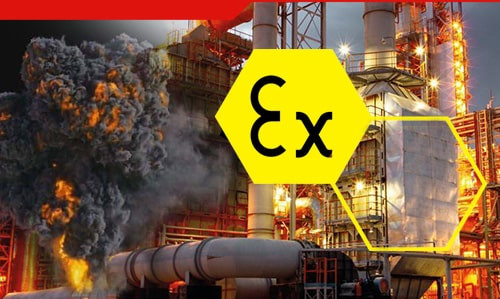

Category


Photos are for informational purposes only. View product specification
please use latin characters
In addition to the sale of explosion-proof components and equipment, as DACPOL we also provide services related to process safety. This includes advice on the selection of specific safeguards and technical systems, as well as support for solutions that minimise the risk of explosion and ensure optimum working conditions in Ex zones.
As part of our fire protection consultancy, we offer:
Perhaps most importantly, we also produce an Explosion Prevention Document (ESD), also known as an Explosion Protection Document (EPD), which is a formal document produced to identify, assess and manage the risks associated with potential explosion hazards in the workplace. It is particularly relevant in industrial plants where there is a risk of explosive atmospheres or other explosive factors.

The ORD covers various aspects, including:
1. identification of explosive atmospheres: identification of areas where there is a risk of explosive atmospheres or other explosive factors.
2. characterisation of combustible substances: description of substances that can lead to explosion, including their physical and chemical properties.
3. risk assessment: an analysis of potential ignition sources, how they can be eliminated or minimised and an assessment of the risks associated with the areas concerned.
4. Application of appropriate safety measures: Identifying necessary safety measures such as ventilation systems, fire extinguishing systems, electrical isolation etc.
5. Training of workers: ensuring that workers are adequately trained in explosion safety, including awareness of hazards and use of personal protective equipment.
6. monitoring and maintenance: define procedures for monitoring and maintaining explosion protection systems to ensure their effectiveness.
The ORD contains a range of information to identify, analyse and control the hazards associated with the possibility of explosive atmospheres in the workplace. The exact content of the Document may vary depending on the specifics of the industrial plant and the regulations in force, but generally includes the following:
The ORD is an important tool for risk management in workplaces, especially in areas where there is a potential risk of explosive atmospheres. It is also required and covered by legislation such as the ATEX directives in force in the European Union.

You may decide to carry out an audit before implementing the ORD. Such an analysis will give you an idea of where the hot spots are within the company. You will then be able to identify priority actions to minimise the risk of explosions. You will be able to stagger your actions and the audit itself will initiate them and highlight the main points.
Are you interested in this product? Do you need additional information or individual pricing?
In addition to the sale of explosion-proof components and equipment, as DACPOL we also provide services related to process safety. This includes advice on the selection of specific safeguards and technical systems, as well as support for solutions that minimise the risk of explosion and ensure optimum working conditions in Ex zones.
As part of our fire protection consultancy, we offer:
Perhaps most importantly, we also produce an Explosion Prevention Document (ESD), also known as an Explosion Protection Document (EPD), which is a formal document produced to identify, assess and manage the risks associated with potential explosion hazards in the workplace. It is particularly relevant in industrial plants where there is a risk of explosive atmospheres or other explosive factors.

The ORD covers various aspects, including:
1. identification of explosive atmospheres: identification of areas where there is a risk of explosive atmospheres or other explosive factors.
2. characterisation of combustible substances: description of substances that can lead to explosion, including their physical and chemical properties.
3. risk assessment: an analysis of potential ignition sources, how they can be eliminated or minimised and an assessment of the risks associated with the areas concerned.
4. Application of appropriate safety measures: Identifying necessary safety measures such as ventilation systems, fire extinguishing systems, electrical isolation etc.
5. Training of workers: ensuring that workers are adequately trained in explosion safety, including awareness of hazards and use of personal protective equipment.
6. monitoring and maintenance: define procedures for monitoring and maintaining explosion protection systems to ensure their effectiveness.
The ORD contains a range of information to identify, analyse and control the hazards associated with the possibility of explosive atmospheres in the workplace. The exact content of the Document may vary depending on the specifics of the industrial plant and the regulations in force, but generally includes the following:
The ORD is an important tool for risk management in workplaces, especially in areas where there is a potential risk of explosive atmospheres. It is also required and covered by legislation such as the ATEX directives in force in the European Union.

You may decide to carry out an audit before implementing the ORD. Such an analysis will give you an idea of where the hot spots are within the company. You will then be able to identify priority actions to minimise the risk of explosions. You will be able to stagger your actions and the audit itself will initiate them and highlight the main points.
 Warunki techniczne dla stref zagrożonych wybuchem
Warunki techniczne dla stref zagrożonych wybuchem
Your review appreciation cannot be sent
Report comment
Report sent
Your report cannot be sent
Write your review
Review sent
Your review cannot be sent
